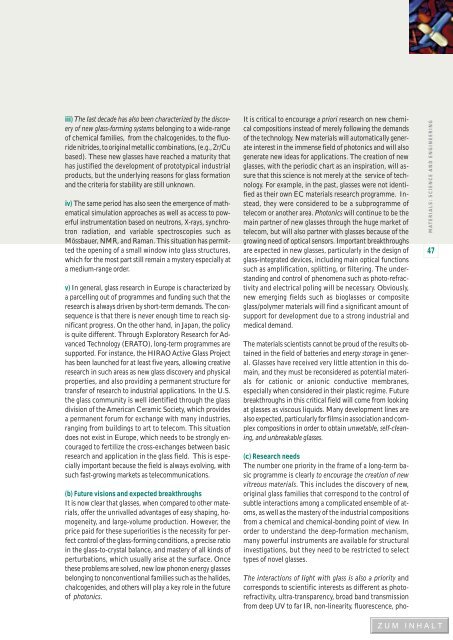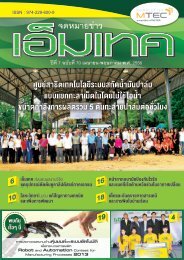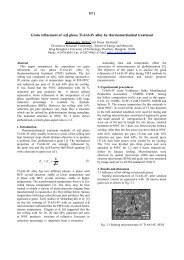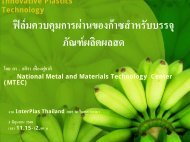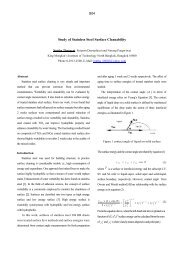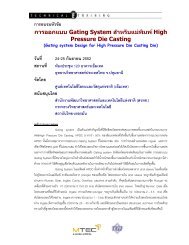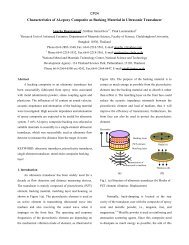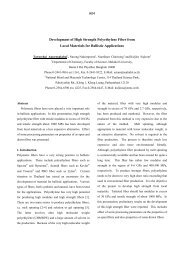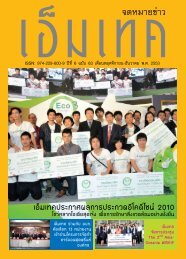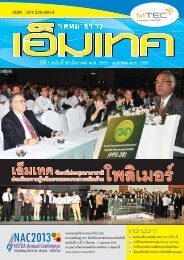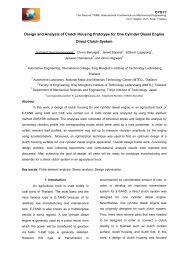EUROPEAN WHITE BOOK
EUROPEAN WHITE BOOK
EUROPEAN WHITE BOOK
Create successful ePaper yourself
Turn your PDF publications into a flip-book with our unique Google optimized e-Paper software.
iii) The last decade has also been characterized by the discoveryof new glass-forming systems belonging to a wide-rangeof chemical families, from the chalcogenides, to the fluoridenitrides, to original metallic combinations, (e.g., Zr/Cubased). These new glasses have reached a maturity thathas justified the development of prototypical industrialproducts, but the underlying reasons for glass formationand the criteria for stability are still unknown.iv) The same period has also seen the emergence of mathematicalsimulation approaches as well as access to powerfulinstrumentation based on neutrons, X-rays, synchrotronradiation, and variable spectroscopies such asMössbauer, NMR, and Raman. This situation has permittedthe opening of a small window into glass structures,which for the most part still remain a mystery especially ata medium-range order.v) In general, glass research in Europe is characterized bya parcelling out of programmes and funding such that theresearch is always driven by short-term demands. The consequenceis that there is never enough time to reach significantprogress. On the other hand, in Japan, the policyis quite different. Through Exploratory Research for AdvancedTechnology (ERATO), long-term programmes aresupported. For instance, the HIRAO Active Glass Projecthas been launched for at least five years, allowing creativeresearch in such areas as new glass discovery and physicalproperties, and also providing a permanent structure fortransfer of research to industrial applications. In the U.S.the glass community is well identified through the glassdivision of the American Ceramic Society, which providesa permanent forum for exchange with many industries,ranging from buildings to art to telecom. This situationdoes not exist in Europe, which needs to be strongly encouragedto fertilize the cross-exchanges between basicresearch and application in the glass field. This is especiallyimportant because the field is always evolving, withsuch fast-growing markets as telecommunications.(b) Future visions and expected breakthroughsIt is now clear that glasses, when compared to other materials,offer the unrivalled advantages of easy shaping, homogeneity,and large-volume production. However, theprice paid for these superiorities is the necessity for perfectcontrol of the glass-forming conditions, a precise ratioin the glass-to-crystal balance, and mastery of all kinds ofperturbations, which usually arise at the surface. Oncethese problems are solved, new low phonon energy glassesbelonging to nonconventional families such as the halides,chalcogenides, and others will play a key role in the futureof photonics.It is critical to encourage a priori research on new chemicalcompositions instead of merely following the demandsof the technology. New materials will automatically generateinterest in the immense field of photonics and will alsogenerate new ideas for applications. The creation of newglasses, with the periodic chart as an inspiration, will assurethat this science is not merely at the service of technology.For example, in the past, glasses were not identifiedas their own EC materials research programme. Instead,they were considered to be a subprogramme oftelecom or another area. Photonics will continue to be themain partner of new glasses through the huge market oftelecom, but will also partner with glasses because of thegrowing need of optical sensors. Important breakthroughsare expected in new glasses, particularly in the design ofglass-integrated devices, including main optical functionssuch as amplification, splitting, or filtering. The understandingand control of phenomena such as photo-refractivityand electrical poling will be necessary. Obviously,new emerging fields such as bioglasses or compositeglass/polymer materials will find a significant amount ofsupport for development due to a strong industrial andmedical demand.The materials scientists cannot be proud of the results obtainedin the field of batteries and energy storage in general.Glasses have received very little attention in this domain,and they must be reconsidered as potential materialsfor cationic or anionic conductive membranes,especially when considered in their plastic regime. Futurebreakthroughs in this critical field will come from lookingat glasses as viscous liquids. Many development lines arealso expected, particularly for films in association and complexcompositions in order to obtain unwetable, self-cleaning,and unbreakable glasses.(c) Research needsThe number one priority in the frame of a long-term basicprogramme is clearly to encourage the creation of newvitreous materials. This includes the discovery of new,original glass families that correspond to the control ofsubtle interactions among a complicated ensemble of atoms,as well as the mastery of the industrial compositionsfrom a chemical and chemical-bonding point of view. Inorder to understand the deep-formation mechanism,many powerful instruments are available for structuralinvestigations, but they need to be restricted to selecttypes of novel glasses.The interactions of light with glass is also a priority andcorresponds to scientific interests as different as photorefractivity,ultra-transparency, broad band transmissionfrom deep UV to far IR, non-linearity, fluorescence, pho-MATERIALS: SCIENCE AND ENGINEERING47


